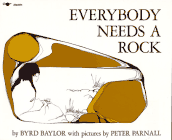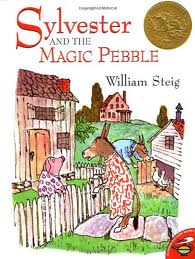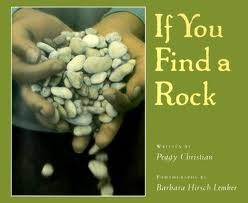Rocks in His Head

by Carol Otis Hurst. Illustrated by James Stevenson. ![]() Picture Book. 32 pages. Grades PreK-3.
Picture Book. 32 pages. Grades PreK-3.
Find this book: Amazon

Review

I've (Carol) been telling the story of my father's lifelong joy in rock collecting for years. He collected rocks and minerals from the time he was a small boy and kept at it through his lifetime, not caring that others (including my mother) thought it was a waste of time. When the Great Depression brought an end to his gas station business, it was those rocks that presented him with a new and far more fulfilling career. It is, I think, an inspiring story and I told it to my own kids because they never knew my father but they tripped over rocks in boxes all over the place--souvenirs of his lifetime's passion.
I started telling audiences at my workshops about my father as a sort of introduction to books about rocks and then to books about following the dream. With those frequent retellings, the story began to take on a set form. That was the point at which I wrote it down for my grandchildren and then realized that, with a little tinkering, it could become the text for a picture book.
An Honor Book for the 2001 Boston Globe, Horn Book Award.
An American Library Association 2002 Notable Book.
New York Public Library's "One Hundred Titles for Reading and Sharing".
Outstanding Science Trade Books for Children (NSTA/CBC).
Obviously we can't be objective in reviewing this book. Therefore we have included here third party reviews and the Book Description from the jacket.
Third Party Reviews
No one bests illustrator James Stevenson in evoking the nostalgic past: with his sketchy pen-and-watercolor washes he brings alive a boy in knickers, the pumps at an old filling station, and early Model Ts. Stevenson must have felt blessed in having Hurst's true and inspiring story about her father, a man with "rocks in his pockets and rocks in his head." to interpret. The boy who loves rocks grows up to open a service station; when customers come for gas or repairs, they stay to look at the ever-growing collection of rocks that lines the walls. Life changes with the onset of the Depression. A particularly poignant illustration captures those "bad times... {when} people couldn't afford to buy new cars of fix their old ones:" with his signature loose line and mixed gray wash, Stevenson depicts an old car abandoned in a field of weeds. Hurst's spare, touching text reveals her father looking for any work he can find, but always ending up at the science museum, looking at the rocks. The sympathetic curator, drawn to this young man who frequents the museum "looking for rocks that are better than mine," offers him a job as janitor and, eventually, curator. Readers will warm to Hurst's rock-solid tale of unwavering dedication and determination. -- Horn Book, July 2001
Hurst tells the story of her father's passion for rock collecting in this gently humorous picture book. "People said he had rocks in his pockets and rocks in his head. He didn't mind. It was usually true." As a boy, he collected rocks. When he grew up, his carefully labeled rock collection occupied a place of honor on the back wall of his filling station. However, once the Depression hit and the filling station closed, he had to look for work. When there was none to be found, he would go to the science museum, where he eventually attracted the attention of the director. A stint as the nighttime janitor, combined with his unquenchable love for rocks, eventually led to his being named Curator of Mineralogy, despite his lack of a college degree. The narrative has the plish of a family story often told and the author paints a touching picture of a man who quietly follows his passion, no matter what others think. Stevenson's watercolor and ink illustrations, with their trademark sketchy style, capture the mild-mannered hero perfectly. Rendered in a palette of soft sepia tones, these warm pictures call to mind an earlier era. Pair this book with Lynne Barasch's Radio Rescue (Farrar, 2000), a smilar biographical tale set in days gone by. Kathleen Kelly MacMillan, Carroll County Public Library, Eldersburg, MD. -- School Library Journal 6/1/01
A big-hearted true story of a man with rocks in his head (and in his pocket), nourished by the deep humanity in Stevenson's watercolors. Hurst's father was a rock hound. His mineralogical thrall started in childhood and he just couldn't collect enough rocks. People said he had rocks in his head. "Maybe I have," he said. "Maybe I have." But he had to earn a living and to that end he ran a filling station, which did good business, and he kept his rock collection on the back shelves of the service bay. Then the Depression cut that business down, so the family moved to a ramshackle old house that her father had to fix up, but not before settling his rock collection up in the attic. He worked at odd jobs as he could find them, but on rainy days when he could find no work, he'd go to the science museum to look at their rock collection. One day the director of the museum has a chat with him, goes home with him to see his collection, and offers him a job as the night janitor, which leads ultimately to a curatorship in mineralogy. The purity of her father's passion for rocks gives power; he's not expecting to make a buck off them, he's just happy to be in their elemental presence. And through good time and bad, he's like one of them -- a rock-- to his family. (Picture book 5 - 9) -- Kirkus Reviews 4/1/01
With great affection and an appealing nostalgia Hurst (Through the Lock) accounts the story of her father, an avid rock collector from the time he was a boy. When people commented that "he had rocks in his pockets and rocks in his head," he would answer with an agreeable "Maybe I have," then reach into his pocket and eagerly add, "take a look at this one." This response, conveying both the hero's humility and passion, becomes a recurring refrain. Stevenson conveys the fellow's easygoing manner with elegant pen-and-ink wash illustrations. Together, author and artist chart the boy's growth into manhood and touch on the world events that shape him. As a young man, he opens a filling station, where he displays his labeled rocks and minerals and learns how to repair the then-new Model T. After the Depression shuts down his business, he moves his cherished collection into the attic of his house, finding odd jobs wherever he can. The story's conclusion will prove as satisfying to readers as it was to Hurst's father; the director of the local museum offers him a dream job -- the position of curator of mineralogy. Dominated by earth tones, Stevenson's artwork convincingly evokes both the personality of this endearing protagonist and the period in which he lived. An emphatic endorsement for youngsters to follow their passions. Ages 5 up. -- Publisher's Weekly
Book Description
Some people collect stamps. Other people collect coins. Carol Otis Hurst's father collected rocks. Nobody ever thought his obsession would amount to anything. They said, "You've got rocks in your head" and "There's no money in rocks." But year after year he kept on collecting, trading, displaying, and labeling his rocks. The Depression forced the family to sell their gas station and their house, but his interest in rocks never wavered. And in the end the science museum he had visited so often realized that a person with rocks in his head was just what was needed.
Anyone who has ever felt a little out of step with the world will identify with this true story of a man who followed his heart and his passion.
(Continued Below)
Advertisement:
(Continued Below)
Advertisement:

Related Books
- If You Find a Rock makes a great companion to Byrd Baylor's Everybody Needs a Rock (Atheneum, 1974 ISBN 0 684 13899 9).
 Everybody Needs a Rock by Byrd Baylor. Illustrated by Peter Parnall. (1974, Atheneum. ISBN 0-689-71051-8. Order Info.) Picture Book. 32 pages. Gr 1-4.
Everybody Needs a Rock by Byrd Baylor. Illustrated by Peter Parnall. (1974, Atheneum. ISBN 0-689-71051-8. Order Info.) Picture Book. 32 pages. Gr 1-4.
With her spare, poetic prose, the author gives us ten rules for picking our own special rocks, leading us through smell, taste, feel and sight. Her locale is southwestern United States and Peter Parnall's illustrations match it well. His lines trail off into the vast spaces and his figures, especially the rocks, seem to grow out of that space. Read More. 
Sylvester and the Magic Pebble by William Steig. (2010, Atheneum. ISBN 9781442416673. Order Info.) Picture Book. 42 pages. Gr K-3.
In this Caldecott Award winner, we find Sylvester collecting pebbles as a hobby. One day he finds an extraordinary red one. Finding it will grant his every wish, he is delighted. When he foolishly wishes to be a rock, he cannot hold on to the pebble to wish himself back. He remains a rock while his father and mother search and then mourn for him. One day, quite by accident, his father places the pebble on him just as his mother wishes he would return to them.
If you find a rock by Peggy Christian. Illustrated by Barbara Hirsch Lember. (2000, Harcourt. ISBN 9780152393397. Order Info.) Picture Book. 32 pages. Gr PreK-3.
In this photo essay style picture book we see children finding different kinds of rocks. These aren't classified by mineral or structure but rather by use: skipping rocks, splashing rocks, climbing rocks, resting rocks. This is an accessible meditation on interacting with one element of nature.
(Continued Below)
Advertisement:

Related Areas Within Carol Hurst's Children's Literature Web Site
- Author information about Carol Otis Hurst.
- Work and Occupations. Featured Subject with related books, activities and links.
- Geology. Featured Subject with related books, activities and links.
- The Great Depression. Featured Subject with related books, activities and links.
